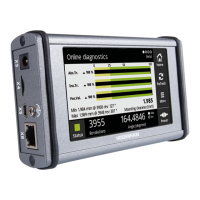December 2001 Data Transmission Protocols 8 – 27
8.4.4 LSV2 Transmission Protocol
The LSV2 protocol is a data transfer protocol for the two-way transfer of
commands and data.
The data is transferred in blocks — so-called telegrams — into which the data
is split up.
The following functions are possible:
n Data transfer
n File management, such as deleting, copying and renaming files
n Changing, creating and deleting paths
n Remote operation of the control functions. The TNC screen appears on the
computer monitor. All functions can be executed from the computer.
n Real DNC operation. Starting and stopping the machine from the computer.
n Diagnosis of TNC error messages and keystrokes for service purposes. The
last 1000 events are stored in the TNC.
HEIDENHAIN offers two LSV2 software packages:
n TNCremo — Software for TNC remote control. Can be run on an AT
compatible PC with MS-DOS. All the above functions are available.
n LSV2 TOOL BOX — Software tools in C programming language for creating
the transfer telegrams. The tool box comprises:
• A library
• Executable files for telegrams
• Source codes
• INCLUDE files for LSV2
• MAKE files
Timeouts You can define your own times for timeouts in the system file OEM.SYS:
n LSV2TIME0 = Timeout for receiving block STX to ETX (standard 3 s)
n LSV2TIME1 = Timeout for acknowledging ENQ or check sum (standard 3 s)
n LSV2TIME2 = Timeout when sending DLE 0, DLE 1 or NAK until a valid
character is received (standard 1 s)
Input range: 0.001 to 3.6 s
Note
If the code words are not defined or if the input range is exceeded, the
standard values are used.

